Casual sandwich chain Potbelly (NASDAQ:PBPB) reported results in line with analysts' expectations in Q4 FY2023, with revenue up 4.7% year on year to $125.7 million. It made a non-GAAP profit of $0.02 per share, down from its profit of $0.09 per share in the same quarter last year.
Potbelly (PBPB) Q4 FY2023 Highlights:
- Revenue: $125.7 million vs analyst estimates of $125.2 million (small beat)
- EPS (non-GAAP): $0.02 vs analyst expectations of $0.03 (33.3% miss)
- Gross Margin (GAAP): 35.3%, up from 29.9% in the same quarter last year
- Same-Store Sales were up 6.3% year on year
- Store Locations: 425 at quarter end, decreasing by 4 over the last 12 months
- Market Capitalization: $392.5 million
With a unique origin story where the company actually started as an antique shop, Potbelly (NASDAQ:PBPB) today is a chain known for its toasty sandwiches.
The ‘Turkey Breast’, for example, is a classic sandwich with hand-sliced turkey breast, Swiss cheese as well as lettuce, tomato, and onions if you’re into those. The ‘Pizza Melt’ is a less traditional hot sandwich featuring pepperoni, meatballs, marinara sauce, and provolone cheese. Potbelly isn’t just a one-trick pony, though, and also offers salads, soups, and desserts such as cookies.
There really is no typical Potbelly customer, but in general, it is someone who wants the comfort of a warm sandwich, food that might be slightly more elevated than traditional fast food, or simply convenient and budget-friendly fare that tastes good. The salad options bring in a more health-conscious customer as well.
Potbelly’s locations are designed to elude feelings of warmth of coziness. There are often vintage and antique elements within the stores that are a nod to the company’s antique shop origins. Unlike traditional fast-food joints, these stores favor warm and neutral colors as well as wood. This former antique shop is not stuck in the past though, as the company has an app that allows busy customers to order ahead of time for pickup to maximize convenience and efficiency.
Modern Fast Food
Modern fast food is a relatively newer category representing a middle ground between traditional fast food and sit-down restaurants. These establishments feature an expanded menu selection priced above traditional fast food options, often incorporating fresher and cleaner ingredients to serve customers prioritizing quality. These eateries are capitalizing on the perception that your drive-through burger and fries joint is detrimental to your health because of inferior ingredients.
Competitors offering convenient and casual dining options include Chipotle (NYSE:CMG), Sweetgreen (NYSE:SG), and Shake Shack (NYSE:SHAK).Sales Growth
Potbelly is a small restaurant chain, which sometimes brings disadvantages compared to larger competitors benefitting from better brand awareness and economies of scale.
As you can see below, the company's annualized revenue growth rate of 4.7% over the last four years (we compare to 2019 to normalize for COVID-19 impacts) was weak , but to its credit, it opened new restaurants and grew sales at existing, established dining locations.
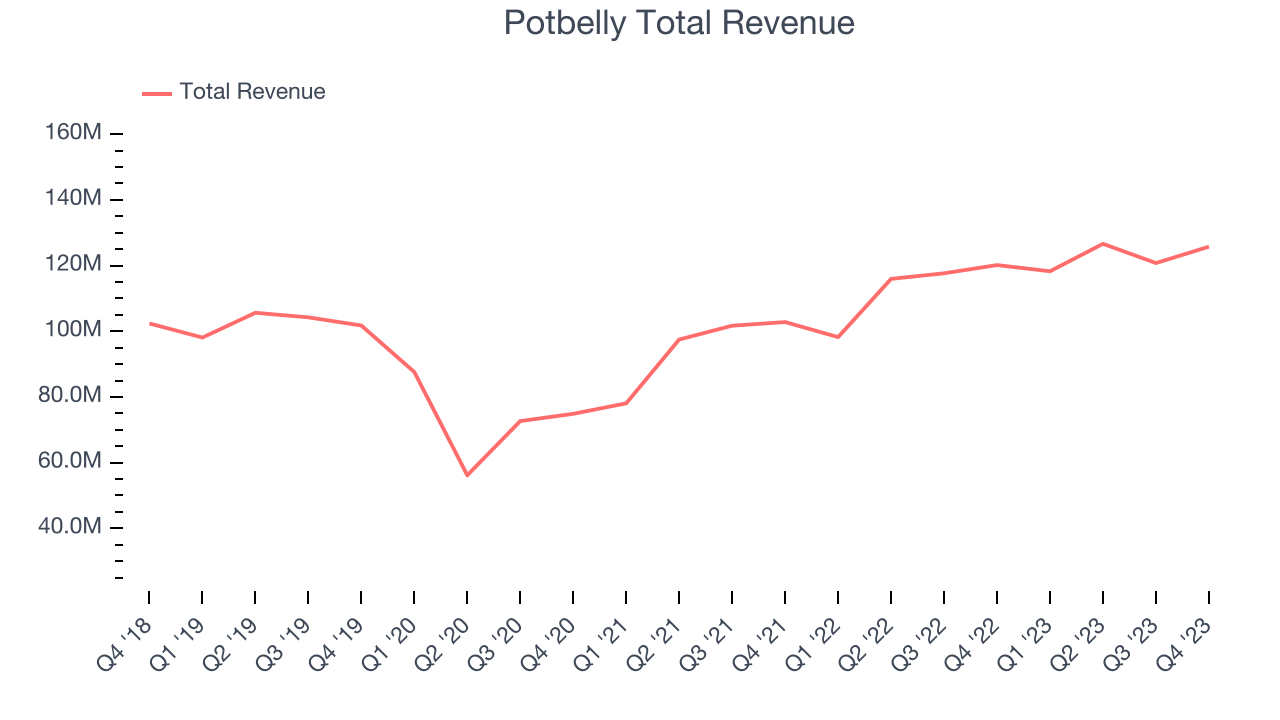
This quarter, Potbelly grew its revenue by 4.7% year on year, and its $125.7 million in revenue was in line with Wall Street's estimates. Looking ahead, Wall Street expects revenue to decline 3.1% over the next 12 months, a deceleration from this quarter.
Number of Stores
A restaurant chain's total number of dining locations is a crucial factor influencing how much it can sell and how quickly company-level sales can grow.
When a chain like Potbelly is opening new restaurants, it usually means it's investing for growth because there's healthy demand for its meals and there are markets where the concept has few or no locations. As of the most recently reported quarter, Potbelly operated 425 total locations, in line with its restaurant count a year ago.
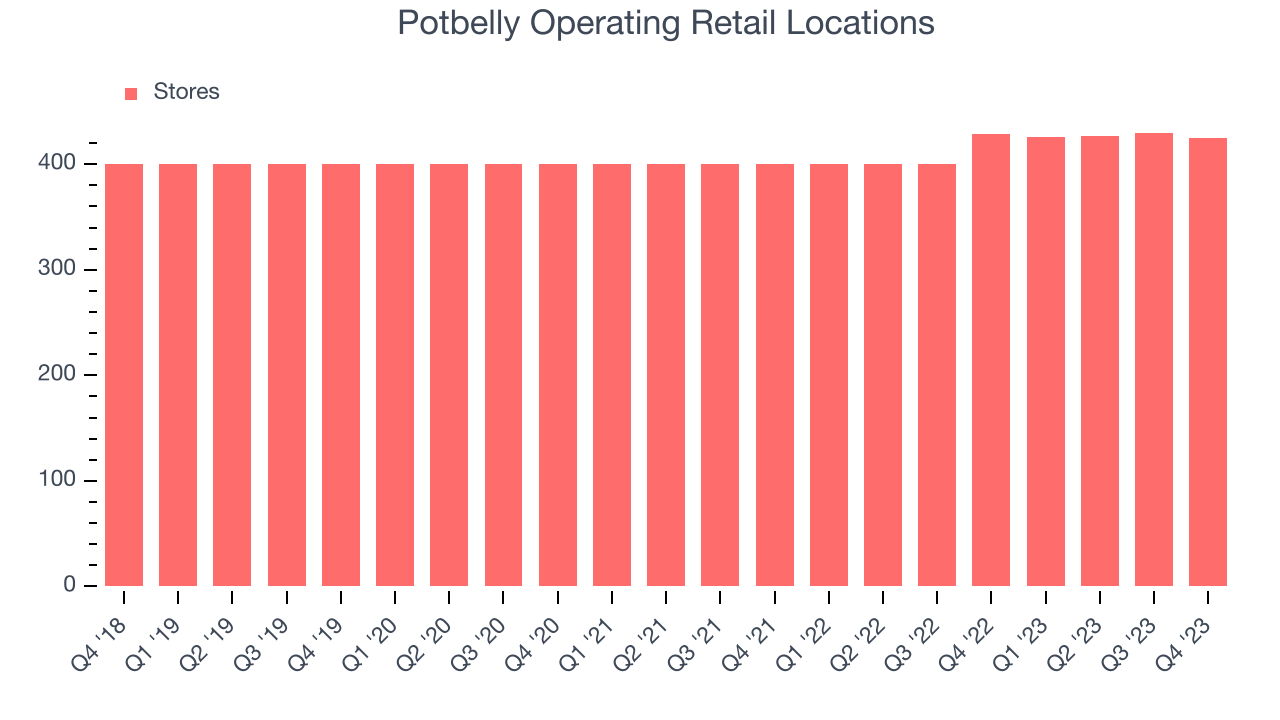
Over the last two years, Potbelly has rapidly opened new restaurants, averaging 3.4% annual increases in new locations. This growth is among the fastest in the restaurant sector and gives Potbelly a chance to scale towards a mid-sized company over time. Analyzing a restaurant's location growth is important because expansion means Potbelly has more opportunities to feed customers and generate sales.
Same-Store Sales
Potbelly's demand has been spectacular for a restaurant business over the last eight quarters. On average, the company has grown its same-store sales by an impressive 15.6% year on year. This performance suggests its steady rollout of new restaurants is beneficial for shareholders. When a chain has strong demand, more locations should help it reach more customers seeking its meals.
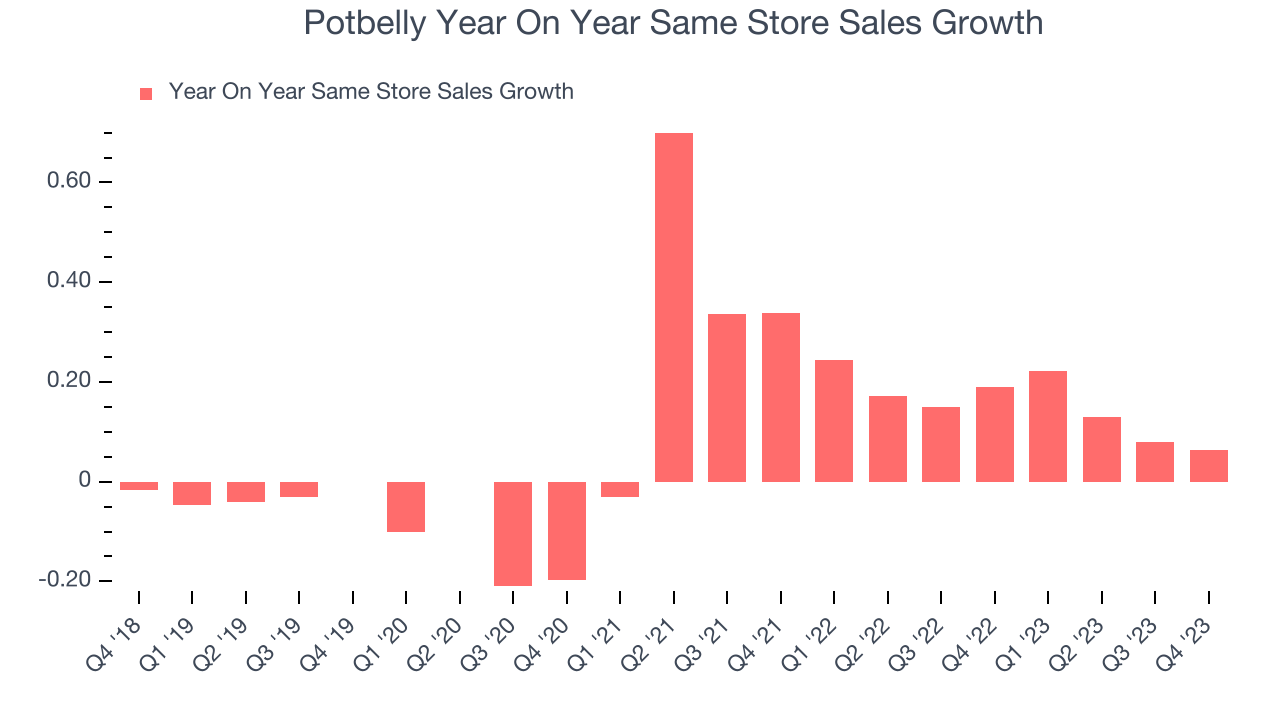
In the latest quarter, Potbelly's same-store sales rose 6.3% year on year. By the company's standards, this growth was a meaningful deceleration from the 18.9% year-on-year increase it posted 12 months ago. We'll be watching Potbelly closely to see if it can reaccelerate growth.
Gross Margin & Pricing Power
We prefer higher gross margins because they make it easier to generate more operating profits.
Potbelly's gross profit margin came in at 35.3% this quarter. up 5.4 percentage points year on year. This means the company makes $0.31 for every $1 in revenue before accounting for its operating expenses.
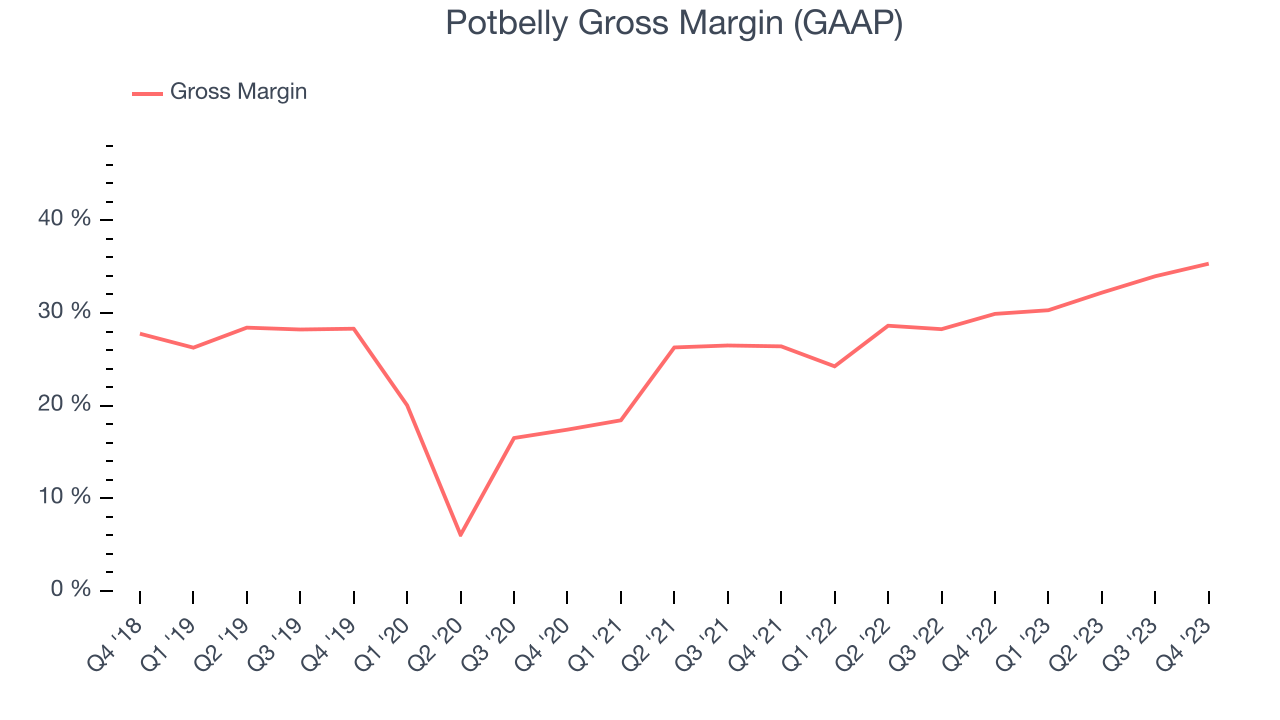
Potbelly's unit economics are higher than the typical restaurant company, giving it the flexibility to invest in areas such as marketing and talent to reach more consumers. As you can see above, it's averaged a decent 30.6% gross margin over the last eight quarters. Its margin has also been trending up over the last 12 months, averaging 18.9% year-on-year increases each quarter. If this trend continues, it could suggest a less competitive environment where the company has better pricing power and more stable input costs (such as ingredients and transportation expenses).
Operating Margin
Operating margin is a key profitability metric for restaurants because it accounts for all expenses keeping the lights on, including wages, rent, advertising, and other administrative costs.
In Q4, Potbelly generated an operating profit margin of 3.4%, in line with the same quarter last year. This indicates the company's costs have been relatively stable.
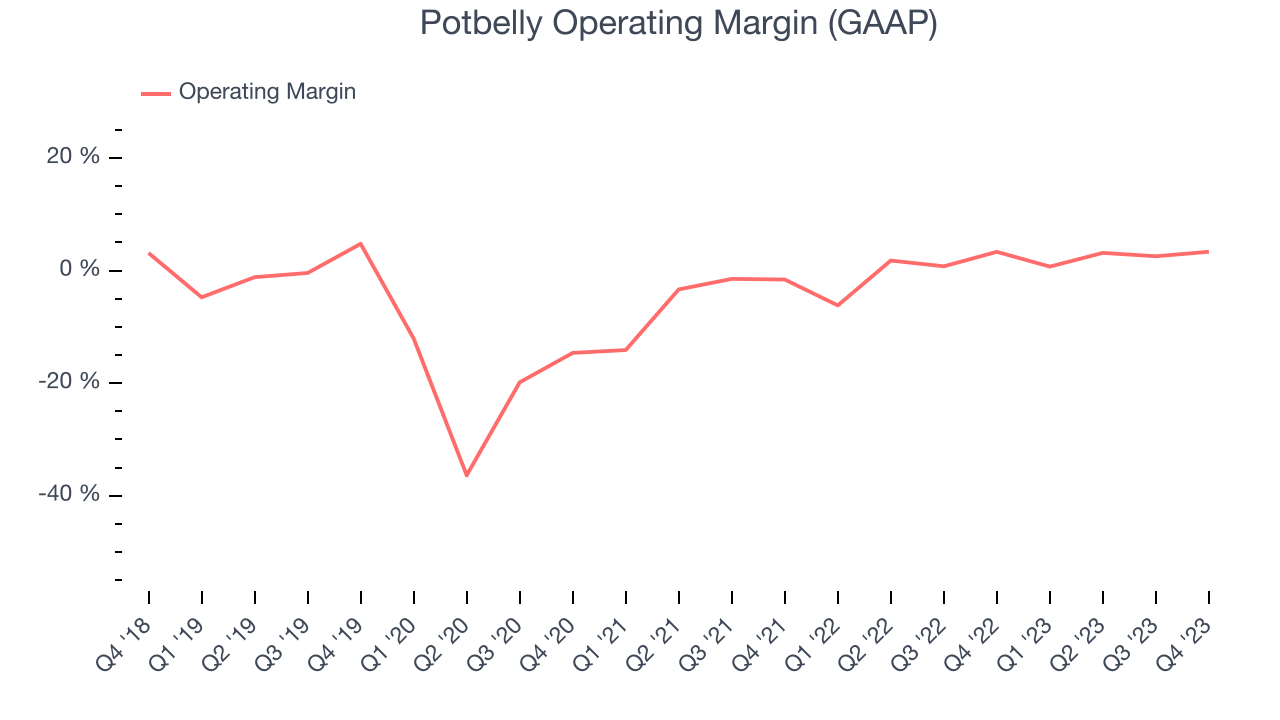 Zooming out, Potbelly was profitable over the last eight quarters but held back by its large expense base. Its average operating margin of 1.4% has been among the worst in the restaurant sector. However, Potbelly's margin has improved, on average, by 2.3 percentage points each year, an encouraging sign for shareholders. The tide could be turning.
Zooming out, Potbelly was profitable over the last eight quarters but held back by its large expense base. Its average operating margin of 1.4% has been among the worst in the restaurant sector. However, Potbelly's margin has improved, on average, by 2.3 percentage points each year, an encouraging sign for shareholders. The tide could be turning.EPS
These days, some companies issue new shares like there's no tomorrow. That's why we like to track earnings per share (EPS) because it accounts for shareholder dilution and share buybacks.
In Q4, Potbelly reported EPS at $0.02, down from $0.09 in the same quarter a year ago. This print unfortunately missed Wall Street's estimates, but we care more about long-term EPS growth rather than short-term movements.
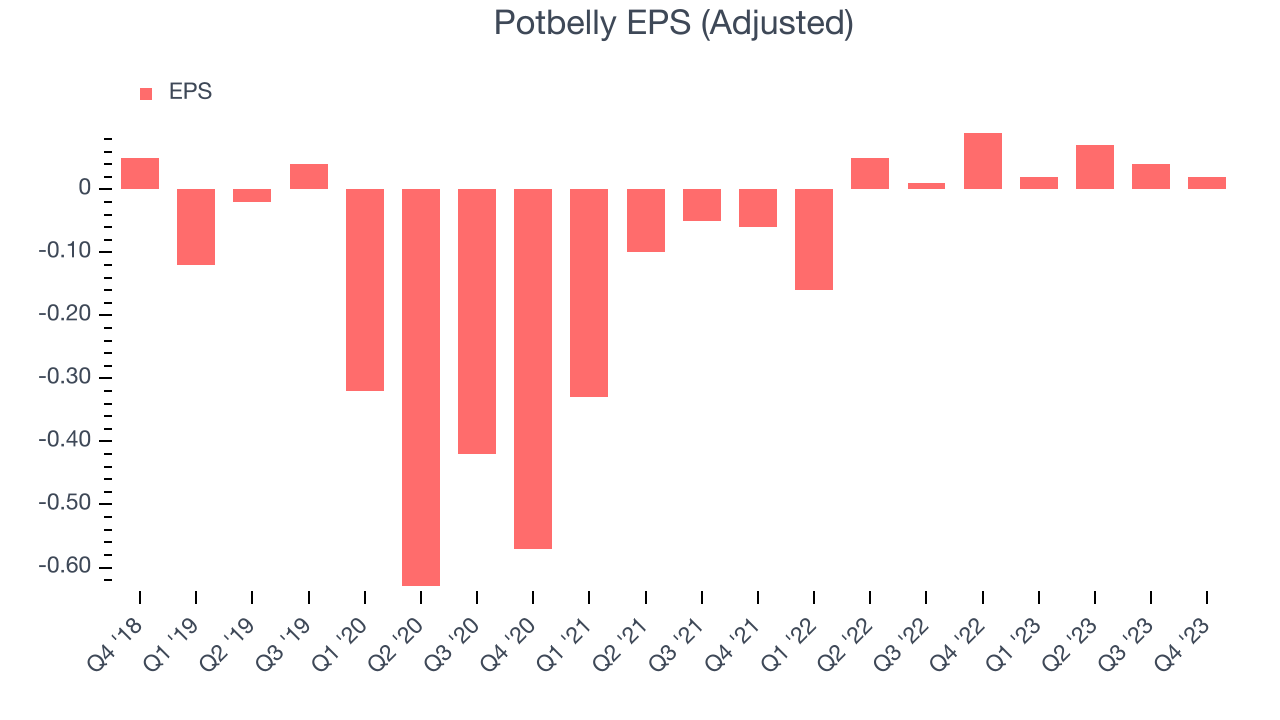
Between FY2020 and FY2023, Potbelly's adjusted diluted EPS grew 108%, translating into a solid 27.6% compounded annual growth rate. This growth is materially higher than its revenue growth over the same period, showing that Potbelly has excelled in managing its expenses.
Wall Street expects the company to continue growing earnings over the next 12 months, with analysts projecting an average 63.3% year-on-year increase in EPS.
Return on Invested Capital (ROIC)
EPS and free cash flow tell us whether a company was profitable while growing revenue. But was it capital-efficient? A company’s ROIC explains this by showing how much operating profit a company makes compared to how much money the business raised (debt and equity).
Potbelly's five-year average ROIC was 31%, placing it among the best restaurant companies. Just as you’d like your investment dollars to generate returns, Potbelly's invested capital has produced excellent profits.
Key Takeaways from Potbelly's Q4 Results
We were impressed by how significantly Potbelly blew past analysts' gross margin expectations this quarter. Other than that, most financial metrics were in line with estimates, including revenue, same-store sales growth, and EPS. For the full-year 2024, Potbelly expects same-store sales growth in the mid-to-low single digits and 10% growth in its number of restaurants. Zooming out, we think this was still a decent quarter, showing that the company is staying on track. The stock is flat after reporting and currently trades at $13.55 per share.
Is Now The Time?
Potbelly may have had a favorable quarter, but investors should also consider its valuation and business qualities when assessing the investment opportunity.
We think Potbelly is a solid business. Although its revenue growth has been a little slower over the last four years with analysts expecting growth to slow from here, its stellar ROIC suggests it has been a well-run company historically. And while its brand caters to a niche market, its projected EPS for the next year implies the company's fundamentals will improve.
Potbelly's price-to-earnings ratio based on the next 12 months is 55.1x. Despite its flashes of high business quality, the state of its balance sheet makes us uncomfortable. We'd like to see the company reduce its leverage before recommending the stock.
Wall Street analysts covering the company had a one-year price target of $14.83 per share right before these results (compared to the current share price of $13.55).
To get the best start with StockStory, check out our most recent stock picks, and then sign up to our earnings alerts by adding companies to your watchlist here. We typically have the quarterly earnings results analyzed within seconds of the data being released, and especially for companies reporting pre-market, this often gives investors the chance to react to the results before the market has fully absorbed the information.
